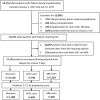Angiotensin II Receptor Blocker Associated With Less Outcome Risk in Patients With Acute Kidney Disease
- PMID: 35517809
- PMCID: PMC9065477
- DOI: 10.3389/fphar.2022.714658
Angiotensin II Receptor Blocker Associated With Less Outcome Risk in Patients With Acute Kidney Disease
Abstract
Objective: The aim of this study was to explore the respective use of angiotensin-converting-enzyme inhibitors (ACEis) or angiotensin receptor blockers (ARBs) on the outcomes of patients who could be weaned from dialysis-requiring acute kidney injury (AKI-D). Methods: This case-control study enrolled 41,731 patients who were weaned from AKI-D for at least 7 days from Taiwan's National Health Insurance Administration. We further grouped AKI-D patients according to ACEi and ARB use to evaluate subsequent risks of all-cause mortality and re-dialysis. The outcomes included the all-cause mortality and new-onset of end-stage kidney disease (ESKD; re-dialysis) following withdraw from AKI-D. Results: A total of 17,141 (41.1%) patients surviving AKI-D could be weaned from dialysis for at least 7 days. The overall events of mortality were 366 (48.9%) in ACEi users, 659 (52.1%) in ARB users, and 6,261 (41.3%) in ACEi/ARB nonusers, during a mean follow-up period of 1.01 years after weaning from AKI-D. In regard to all-cause of mortality, pre-dialysis ARB users had lower incidence than ACEi users [hazard ratio (HR 0.82), p = 0.017]. Compared with ACEi/ARB nonusers, continuing ARB users had a significantly low risk of long-term all-cause mortality (adjusted hazard ratio 0.51, p = 0.013) after propensity score matching. However, new users of ACEi at the acute kidney disease (AKD) period had a higher risk of re-dialysis after weaning than ACEi/ARB nonusers (aHR 1.82, p < 0.001), whereas neither ACEi nor ARB users confronted significantly increased risks of hyperkalemia after weaning. Conclusions: Compared with patients without ACEi/ARB, those continuing to use ARB before the event and after weaning had low all-cause mortality, while new users of ACEi at AKD had increased risk of re-dialysis. AKI-D patients continuing to use ACEi or ARB did not have higher risk of hyperkalemia. Future prospective randomized trials are expected to confirm these findings.
Keywords: ACEi; AKD; AKI; ARB; dialysis; hyperkalemia; mortality; weaning.
Copyright © 2022 Wu, Lin, Teng, Yang, Chou, Tsao, Chen, Chueh and Chen.
Conflict of interest statement
The authors declare that the research was conducted in the absence of any commercial or financial relationships that could be construed as a potential conflict of interest.
Figures




Similar articles
-
The Impact of Angiotensin-Converting Enzyme Inhibitors or Angiotensin II Receptor Blockers on Clinical Outcomes of Acute Kidney Disease Patients: A Systematic Review and Meta-Analysis.Front Pharmacol. 2021 Jul 20;12:665250. doi: 10.3389/fphar.2021.665250. eCollection 2021. Front Pharmacol. 2021. PMID: 34354583 Free PMC article. Review.
-
Angiotensin II Receptor Blockers but Not Angiotensin-Converting Enzyme Inhibitors Are Associated With a Reduced Risk of Acute Kidney Injury After Major Surgery.Front Pharmacol. 2021 Apr 23;12:662301. doi: 10.3389/fphar.2021.662301. eCollection 2021. Front Pharmacol. 2021. PMID: 33967804 Free PMC article.
-
Effect of Post-Acute Kidney Injury Use of Renin-Angiotensin Inhibitors on Long-term Mortality and Major Adverse Kidney Events: A 5-year Retrospective Observational Cohort Study.Kidney Med. 2025 Mar 20;7(5):100996. doi: 10.1016/j.xkme.2025.100996. eCollection 2025 May. Kidney Med. 2025. PMID: 40321973 Free PMC article.
-
Use of Angiotensin-Converting Enzyme Inhibitors/Angiotensin Receptor Blockers and Acute Kidney Disease after an Episode of AKI: A Multicenter Prospective Cohort Study.Am J Nephrol. 2020;51(4):266-275. doi: 10.1159/000505893. Epub 2020 Feb 21. Am J Nephrol. 2020. PMID: 32088714
-
Safety of ACEI/ARB use in the early (<3 months) post kidney transplant period: a systematic review and meta-analysis.Front Pharmacol. 2024 Dec 11;15:1522558. doi: 10.3389/fphar.2024.1522558. eCollection 2024. Front Pharmacol. 2024. PMID: 39726791 Free PMC article.
Cited by
-
Impact of Different Angiotensin-Converting Enzyme Inhibitors or Angiotensin Receptor Blocker Resumption Timing on Post Acute Kidney Injury Outcomes.Kidney Int Rep. 2024 Aug 31;9(11):3290-3300. doi: 10.1016/j.ekir.2024.08.027. eCollection 2024 Nov. Kidney Int Rep. 2024. PMID: 39534209 Free PMC article.
-
Unveiling the enigma of acute kidney disease: predicting prognosis, exploring interventions, and embracing a multidisciplinary approach.Kidney Res Clin Pract. 2024 Jul;43(4):406-416. doi: 10.23876/j.krcp.23.289. Epub 2024 Jun 25. Kidney Res Clin Pract. 2024. PMID: 38934037 Free PMC article.
-
The effects of angiotensin-converting enzyme inhibitors and angiotensin II receptor blockers in critically ill patients with acute kidney injury: An observational study using the MIMIC database.Front Pharmacol. 2022 Aug 29;13:918385. doi: 10.3389/fphar.2022.918385. eCollection 2022. Front Pharmacol. 2022. PMID: 36105224 Free PMC article.
-
Risk factors for postoperative acute kidney injury in colorectal cancer: a systematic review and meta-analysis.Int J Colorectal Dis. 2025 Mar 18;40(1):70. doi: 10.1007/s00384-025-04860-7. Int J Colorectal Dis. 2025. PMID: 40100411 Free PMC article.
-
Role of G protein coupled receptors in acute kidney injury.Cell Commun Signal. 2024 Sep 2;22(1):423. doi: 10.1186/s12964-024-01802-8. Cell Commun Signal. 2024. PMID: 39223553 Free PMC article. Review.
References
-
- Arora P., Rajagopalam S., Ranjan R., Kolli H., Singh M., Venuto R., et al. (2008). Preoperative Use of Angiotensin-Converting Enzyme Inhibitors/angiotensin Receptor Blockers Is Associated with Increased Risk for Acute Kidney Injury after Cardiovascular Surgery. Clin. J. Am. Soc. Nephrol. 3 (5), 1266–1273. 10.2215/CJN.05271107 - DOI - PMC - PubMed
-
- Brar S., Ye F., James M. T., Hemmelgarn B., Klarenbach S., Pannu N., et al. (2018). Chronic Disease: Association of Angiotensin-Converting Enzyme Inhibitor or Angiotensin Receptor Blocker Use with Outcomes after Acute Kidney Injury. JAMA Intern. Med. 178 (12), 1681–1690. 10.1001/jamainternmed.2018.4749 - DOI - PMC - PubMed
LinkOut - more resources
Full Text Sources

